Sustainability Program
Our Sustainability Mission
- People: We are committed to improving the health and well-being of our patients, families, workforce and our local and global community.
- Planet: We will work to promote a healthy environment to further our mission to provide hope, care and cures to help every child live the healthiest and most fulfilling life possible.
- Promise: We will support our promise to care for every child who needs us – regardless of their family’s ability to pay – by implementing sustainable practices that enhance patient care, reduce costs and minimize our environmental footprint.
Leadership
 Seattle Children’s has long been a leader and a believer in healthy environments for children and families. Sustainability impacts individual health, community health and health equity. Climate change-related weather, such as extreme heat events, can lead to negative health outcomes for all. Children are especially sensitive to environmental changes and, combined with other social determinants of health, are more vulnerable to poor health outcomes.
Seattle Children’s has long been a leader and a believer in healthy environments for children and families. Sustainability impacts individual health, community health and health equity. Climate change-related weather, such as extreme heat events, can lead to negative health outcomes for all. Children are especially sensitive to environmental changes and, combined with other social determinants of health, are more vulnerable to poor health outcomes.
Seattle Children’s has built a sustainability program to minimize the environmental impacts of our operations. We are proud of the sustainability work already accomplished in many areas such as waste diversion, alternative transportation, healthy food purchasing and green building.
A strong foundation in these programs begins with our data driven approach. Data is used to measure our baseline to track progress as existing programs are expanded or new programs are implemented. Our energy efficiency work is a great example of our use of data. As a result of past efforts, we have received numerous recognitions from organizations devoted to sustainability such as Practice Greenhealth and the Arbor Day Foundation. Seattle Children’s is also the only hospital in the U.S. recognized as a Salmon Safe Certified Campus. This is a five-year certification first received in 2017 and renewed in 2022 that requires additional efforts for each renewal cycle.
Building on this strong foundation, current initiatives focus on energy efficiency, waste reduction and greenhouse gas emissions reduction.
Seattle Children's Earns Recognition for Sustainability
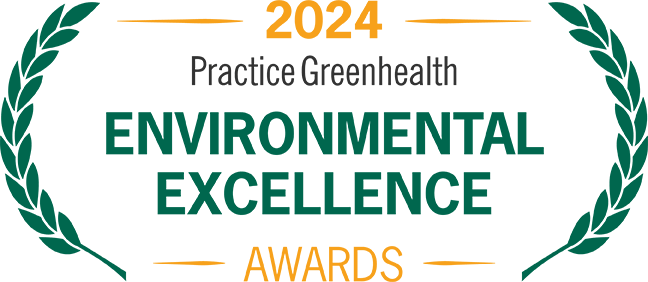 Practice Greenhealth recognized Seattle Children's in three categories: Top 25 Environmental Excellence Award Honoree, the highest honor given to hospitals; Greening the OR recognition for efforts to improve environmental performance in operating rooms; and Circle of Excellence in Water, achieving the top 10 hospital ranking in various water metrics.
Practice Greenhealth recognized Seattle Children's in three categories: Top 25 Environmental Excellence Award Honoree, the highest honor given to hospitals; Greening the OR recognition for efforts to improve environmental performance in operating rooms; and Circle of Excellence in Water, achieving the top 10 hospital ranking in various water metrics.
Current Goals
Greenhouse gas emissions and climate change
Healthcare facilities are complex buildings running 24/7/365. As a result, healthcare facilities contribute significant greenhouse gas emissions from energy consumption to operate buildings, procuring and disposing of medical equipment and staff commuting to the hospital. Approximately 8.5% of all emissions in the U.S. can be attributed to the healthcare industry. Our operations keep our patients, families and staff safe and comfortable. Yet, climate change impacts a wide range of negative health outcomes. Increased exposure pathways, such as heat stress and poor air quality, put people at higher risk as determined by the difference in their exposure, sensitivity and ability to adapt to those hazards. Children, specifically, are one of the most vulnerable populations to the effects of climate change.
Seattle Children’s is dedicated to reducing our emissions to limit the impact of climate change and provide better health outcomes for our patients, families, staff and communities we serve. To that end, we have:
- Signed the Health and Human Services Health Care Climate Pledge in June 2022 to reduce organizational emissions (Scopes 1 and 2) in half by 2030 and all emissions (including Scope 3) to net zero by 2050.
- Committed to become carbon neutral in 2025 at the hospital by offsetting all Scope 1 and 2 emissions and limited Scope 3 emissions of business travel and commuting.
Our Climate Action Plan serves as our roadmap to reduce our emissions. Reducing the impact of our operations is directly tied to our mission to help every child live the healthiest and most fulfilling life possible.
Current Initiatives
-
Emissions inventory and reduction
The organization-wide emissions inventory for 2023* is shown below:

*2023 data is in process. Totals show estimated amounts in some categories.
Organizational emissions (Scopes 1 and 2) have been reduced by 8.6% between 2022 and 2023, the first two years a full inventory was completed. A further breakdown of organizational (Scopes 1 and 2) emissions for 2023:

The relevant carbon neutral emissions reduction progress is shown below with over 20% reduction since the goal was announced. Note: Forest B opened in 2022 adding 30% to our operating footprint and increasing emissions from previous year.
-
Energy efficiency
 Healthcare demands energy produce positive patient outcomes; powerful magnets see inside people without an incision, teams perform lifesaving surgeries in sterile environments, and patients receive care 24/7. Immense amounts of energy heat and cool buildings, light office areas and support clinical programs and patient care. These needs put energy efficiency in service of a greater mission.
Healthcare demands energy produce positive patient outcomes; powerful magnets see inside people without an incision, teams perform lifesaving surgeries in sterile environments, and patients receive care 24/7. Immense amounts of energy heat and cool buildings, light office areas and support clinical programs and patient care. These needs put energy efficiency in service of a greater mission.A facility wide strategy to identify and complete energy savings projects started with an energy audit across the entirety of the hospital campus to standardize energy usage and identify opportunities with clearly defined returns. These opportunities formed a roadmap for capital and expense projects to reduce energy usage. The initial round of projects is currently in progress. However, the efforts have led to a broader focus on conservation efforts within our Facilities teams and we have already seen results. As of early 2024, efforts have yielded an energy reduction of nearly 20% and ongoing work should further energy reduction leading to increased efficiency, lower greenhouse gas emissions and cost savings.
-
Waste diversion
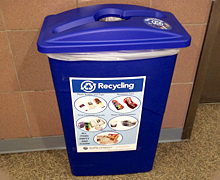 Healthcare uses a tremendous amount of supplies and equipment to provide care for all patients. Many of these items are disposable and end up in landfills, which contribute to emissions and growing pollution across the globe, including in oceans. Healthcare must do all it can to divert as much waste as possible to avoid adding to this burden.
Healthcare uses a tremendous amount of supplies and equipment to provide care for all patients. Many of these items are disposable and end up in landfills, which contribute to emissions and growing pollution across the globe, including in oceans. Healthcare must do all it can to divert as much waste as possible to avoid adding to this burden.Seattle Children’s aims to divert 50% of waste from landfills generated at main campus by 2025. The total diversion rate was over 46% in 2023, leaving room for improvement to meet the target.
To achieve this goal, we have an extensive recycling operation, for everything from the more common paper and hard plastics to batteries, light bulbs, electronic devices and scrap metals.
Food and landscaping trimmings are composted. For food waste, a robust composting operation that started in staff kitchens expanded throughout the hospital in 2021.
-
Healthy and sustainable food purchasing
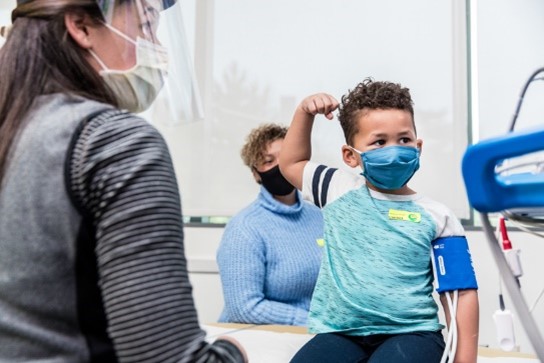 The mission of our Nutrition Department is “Nourishing our community to thrive… each and every life.” The team tracks purchasing of all food served in the Ocean Café and delivered to patient rooms to provide our patients, families and staff the healthiest choices.
The mission of our Nutrition Department is “Nourishing our community to thrive… each and every life.” The team tracks purchasing of all food served in the Ocean Café and delivered to patient rooms to provide our patients, families and staff the healthiest choices. Food production is responsible for about 25% of the greenhouse gas emissions in the world. Livestock specifically accounts for 60% of the total emissions. Antibiotics have been overused in animal agriculture leading to a rise in antibiotic-resistant infections.
Sustainable and local purchasing further promotes health equity and supports building regional economies that promote small businesses.
In 2023, over 50% of meat served was antibiotic-free, 21% of all food was sustainably procured and 21% was locally procured.
-
Green Team network
Seattle Children’s has more than 300 staff members as part of a Green Team to both educate and disseminate sustainability efforts to every department in the organization. The Green Team’s mission statement says it all: “Seattle Children’s Green Team will lead, educate, inspire and empower our workforce in safeguarding the health and preserving the resources of present and future generations. We endeavor to reduce both environmental impact and hospital costs through efficient, sustainable work practices.”
-
Making sustainable transportation options attractive
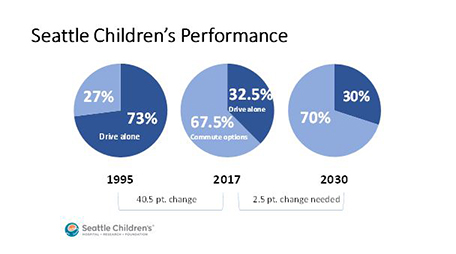
According to the Environmental Protection Agency, the transportation sector is responsible for 29% of the greenhouse gas emissions in the United States. This is just slightly below the emissions caused by coal-burning power plants. As hospitals tend to be one of the largest employers in the community in which they are located, we feel a responsibility to decrease this environmental load.
Seattle Children’s has a nationally recognized employee transportation program and is the only hospital in the country that has received a platinum-level Bicycle Friendly Business Award. Over the last two decades, Seattle Children’s has reduced the percent of employee drive-alone commute trips by more than half – from 73% in 1995 to 32.5% in 2017– and has a goal of just 30% by 2030. Reducing vehicle trips supports Seattle Children’s triple aim of providing value to our employees; reducing organizational expense associated with parking vehicles; and improving air quality, which supports the health of the children we serve.
Highlights of Seattle Children’s employee transportation program include:
- Deeply discounted unlimited ORCA transit pass
- A daily commute bonus on days staff do not drive alone
- Free, premium vanpool parking
- Free use of a bike for employees who commit to biking to work twice a week
- On-site, full-service bike shop, offering discounts on bicycles, gear and accessories plus two free annual bicycle tune-ups
- Pay-per-use parking rates that differ by location and time of day
-
Green buildings
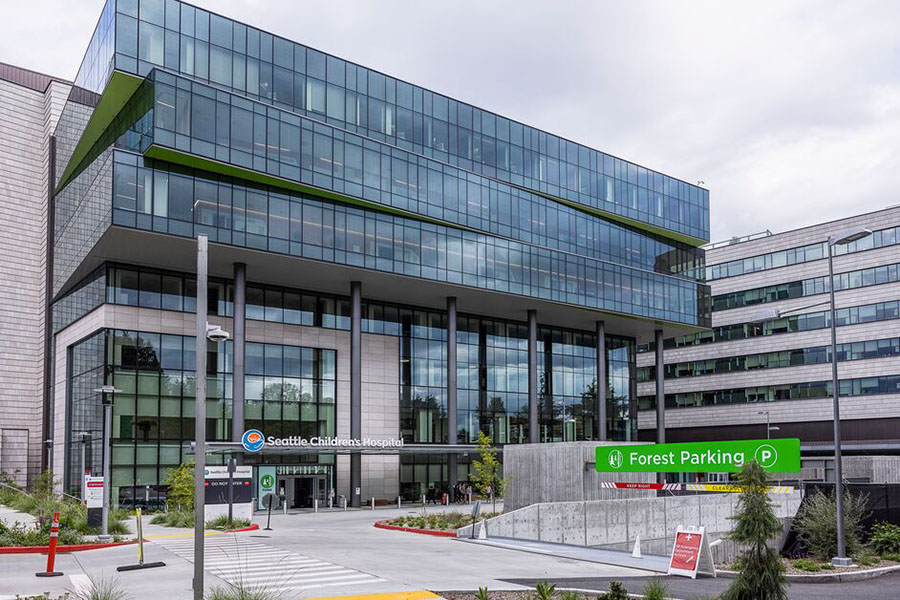 Seattle Children's Forest B
Seattle Children's Forest BHealthcare organizations across the country are creating high-performance buildings that deliver healing environments for their patients; sustainability work prioritizes using less resources to create these spaces as efficiently as possible. Seattle Children’s has been a leader in sustainable green buildings with many of our facilities certified as LEED®, a rigorous green building certification system from the U.S. Green Building Council.
The newest hospital wing, Forest B, fully opened in 2022 at the Laurelhurst campus achieving LEED® Gold Certification. The building set an ambitious energy performance goal during the integrated design process, with a projected Energy Use Index of 116. A heat recovery chiller, high performance HVAC and lighting were included as part of this process.
The previous hospital expansion, Forest A, opened in 2013 achieving LEED® Gold Certification. This building prioritized both patient comfort and energy and water efficiency. This includes low-flow plumbing fixtures, high-efficiency heating and plentiful windows in patient rooms for natural light. To optimize indoor air quality, the facility features increased ventilation and used paints, adhesives and flooring with low volatile organic compounds. Interiors finishes used regional materials, Forest Stewardship–certified wood and wood products with no added urea-formaldehyde.
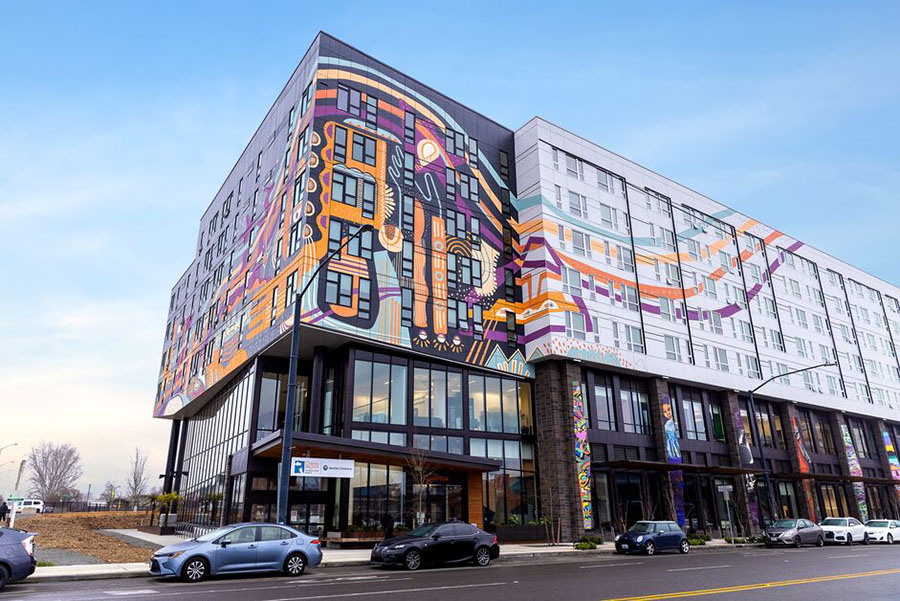 Seattle Children's Odessa Brown Children's Clinic's Othello building
Seattle Children's Odessa Brown Children's Clinic's Othello buildingSurrounding this building are native and drought-tolerant landscaping and high-efficiency irrigation with a beautiful rooftop garden so all patients and families have a healing place of respite. The project team diverted more than 90% of our construction waste from the landfill on this project.
Odessa Brown Children’s Clinic opened in the Othello neighborhood of South Seattle in 2022 aligned with many of the LEED® criteria. The building is certified as LEED® Gold for Multifamily Midrise as a shared use affordable housing building.
Our South Clinic in Federal Way, completed in 2015, was a re-use project of an old retail store, a wonderful way to reduce construction resources.
Similarly, the North Clinic in Everett opened in 2018 to serve the North Sound, replacing smaller clinics, and is aligned with many LEED® criteria, though certification was not pursued.
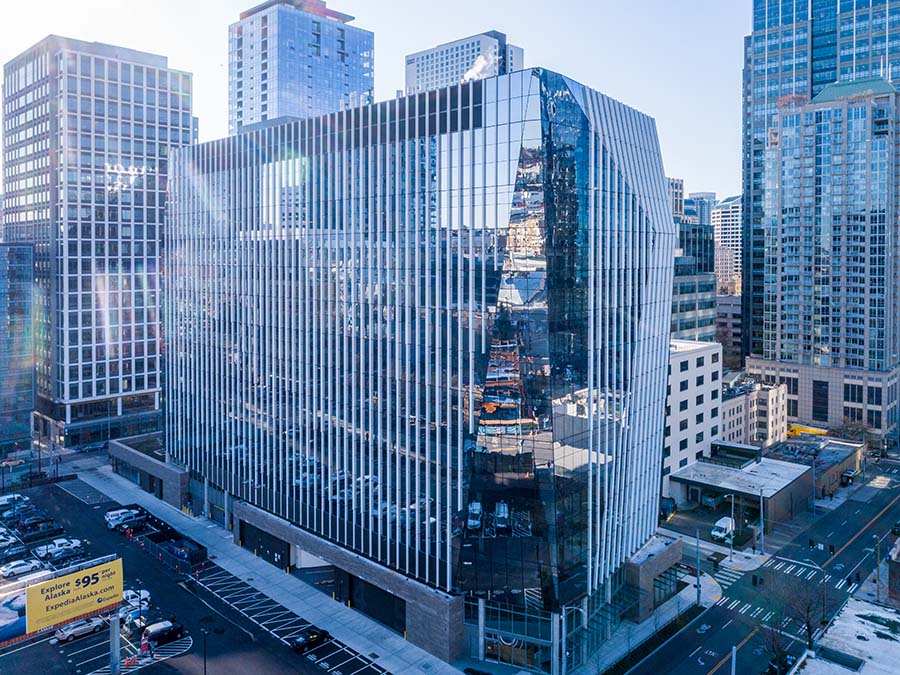 Seattle Children's Research Institute's B. Wayne Hughes Building, also known as Building Cure
Seattle Children's Research Institute's B. Wayne Hughes Building, also known as Building CureSeattle Children's Research Institute's B. Wayne Hughes Building, also known as Building Cure, located in downtown Seattle, opened in 2020 receiving LEED® Gold Certification. Bellevue Clinic and Surgery Center was completed in 2010 to serve our patients and families in East King County, receiving LEED® Gold Certification.
-
Water reduction
Clean, fresh water is not an unlimited resource. Hospital operations provide multiple opportunities for water reduction and, as space are updated, high efficiency plumbing fixtures are installed.
The Laurelhurst campus is a large and beautifully landscaped, which requires irrigation water in the dry summer months to stay healthy. Native and drought-tolerant plants, shrubs and trees decrease the amount of water needed and upgraded irrigation equipment have yielded a million gallons of water per year savings.
-
Green purchasing and paper reduction
Even in the digital age, hospitals remain paper intensive. Paper production necessitates thousands of trees and millions of gallons of water. The manufacturing process produces greenhouse gases and air-polluting particles; these fine particles contribute to respiratory issues. Asthma and asthma-related issues are the most common reasons for admission to Seattle Children’s and to have the greatest effect, paper usage must decrease. Since 2014, our annual usage decreased by 60%, despite hospital growth. We have committed to consume less paper to continue this progress.
Furniture can have a range of toxic chemicals included in the manufacturing process. As part of our work in the Healthier Hospitals, Healthy Interiors challenge, sourcing of new furniture means over 80% of furniture is free of harmful chemicals.
The green purchasing program continues to expand to source materials that are environmentally preferable to protect the health of our children, families and staff.
-
Healthier Hospitals
Healthier Hospitals is a national campaign to improve environmental health and sustainability in the healthcare sector. Seattle Children’s has committed to all six priority challenges: 1) engaged leadership, 2) healthier food, 3) leaner energy, 4) less waste, 5) safer chemicals and 6) smarter purchasing. This initiative has helped frame how we address everything from purchasing interior furniture without harmful chemicals to sourcing local and sustainable food for our patients, families and staff.
Contact Information
If you would like more information about Seattle Children’s sustainability initiatives, please contact our team.
